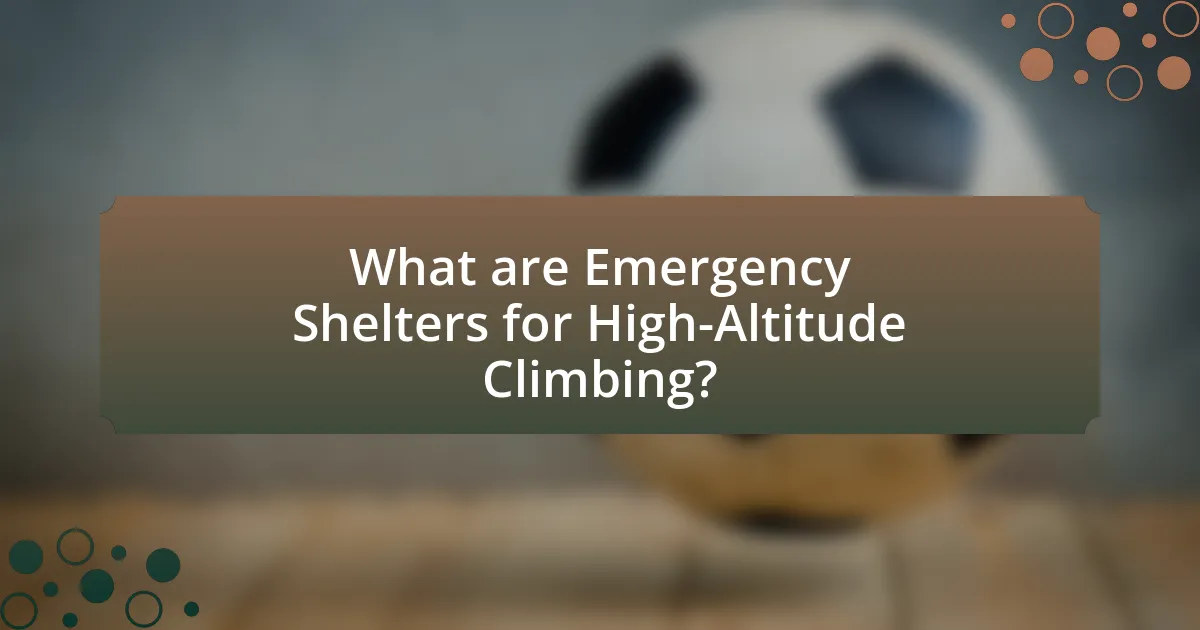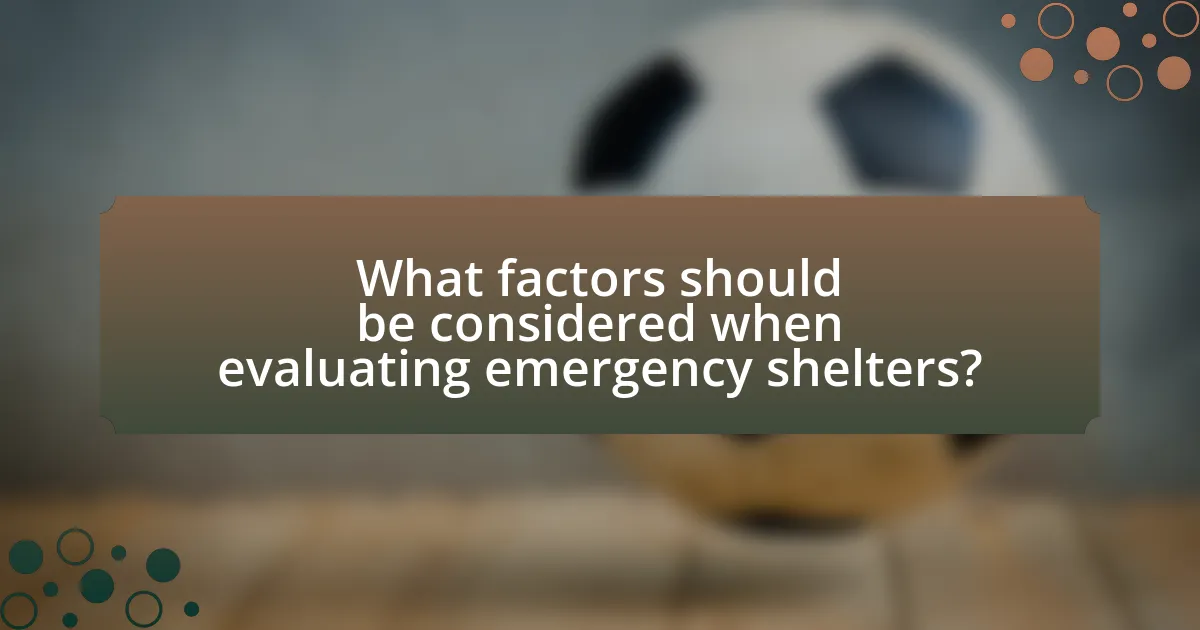Emergency shelters for high-altitude climbing are specialized, portable structures designed to provide climbers with immediate protection in extreme weather conditions. This article evaluates the essential features, materials, and design elements that differentiate emergency shelters from regular tents, emphasizing their importance in high-altitude environments where climbers face risks such as altitude sickness and severe weather. Key factors for assessing these shelters include weight, insulation, weather resistance, and ease of setup, which directly impact climbers’ safety and survival chances. The article also reviews top emergency shelter options currently available, highlighting reputable brands and common pitfalls to avoid during selection.

What are Emergency Shelters for High-Altitude Climbing?
Emergency shelters for high-altitude climbing are specialized, portable structures designed to provide immediate protection and safety for climbers in extreme weather conditions or emergencies. These shelters are typically lightweight, compact, and made from durable, weather-resistant materials to withstand harsh environments. They serve as a refuge against elements such as wind, snow, and cold temperatures, ensuring climbers can survive until rescue or until conditions improve. The effectiveness of these shelters is supported by their design, which often includes features like insulation, ventilation, and ease of setup, making them essential gear for high-altitude expeditions.
How do emergency shelters differ from regular tents?
Emergency shelters differ from regular tents primarily in their design and intended use. Emergency shelters are specifically engineered for rapid deployment and protection in extreme conditions, often featuring materials that provide enhanced insulation and weather resistance. For instance, many emergency shelters are made from lightweight, durable fabrics that can withstand high winds and heavy precipitation, which is crucial in high-altitude environments. In contrast, regular tents are typically designed for recreational camping and may not offer the same level of protection or ease of setup under adverse weather conditions. This distinction is supported by the fact that emergency shelters are often used in disaster relief scenarios, where speed and reliability are essential, while regular tents are used for leisure activities where conditions are generally more stable.
What materials are commonly used in high-altitude emergency shelters?
High-altitude emergency shelters commonly utilize materials such as nylon, polyester, and aluminum. These materials are chosen for their lightweight properties, durability, and resistance to extreme weather conditions. Nylon and polyester are often used for the shelter fabric due to their ability to withstand harsh winds and snow, while aluminum is frequently employed for structural components because of its strength-to-weight ratio. The effectiveness of these materials is supported by their widespread use in outdoor gear and emergency equipment, which has been tested in various high-altitude environments.
What design features are essential for high-altitude emergency shelters?
Essential design features for high-altitude emergency shelters include insulation, wind resistance, lightweight materials, and ease of assembly. Insulation is critical to retain heat in extreme cold, as temperatures can drop significantly at high altitudes. Wind resistance is necessary to withstand strong gusts that are common in mountainous regions, ensuring the shelter remains stable and secure. Lightweight materials facilitate easy transport and quick setup, which is vital during emergencies when time is of the essence. Additionally, ease of assembly allows climbers to erect the shelter rapidly under challenging conditions, enhancing survival chances. These features are supported by research indicating that effective emergency shelters must address the unique environmental challenges posed by high-altitude conditions.
Why is it important to evaluate emergency shelters for high-altitude climbing?
Evaluating emergency shelters for high-altitude climbing is crucial because these shelters provide essential protection against extreme weather conditions and life-threatening situations. High-altitude environments are characterized by rapid weather changes, low temperatures, and high winds, which can lead to hypothermia or frostbite. Research indicates that climbers face increased risks at elevations above 8,000 meters, where the likelihood of severe weather events rises significantly. Therefore, assessing the structural integrity, insulation properties, and accessibility of emergency shelters ensures that climbers have reliable refuge options during emergencies, ultimately enhancing their chances of survival.
What risks do climbers face at high altitudes that shelters must address?
Climbers at high altitudes face several significant risks that shelters must address, including altitude sickness, extreme weather conditions, and reduced oxygen levels. Altitude sickness, which can manifest as headaches, nausea, and fatigue, occurs due to lower oxygen availability, affecting climbers’ physical performance and decision-making. Extreme weather conditions, such as severe cold, high winds, and snowstorms, can lead to hypothermia and frostbite, necessitating shelters that provide adequate insulation and protection. Additionally, reduced oxygen levels can impair cognitive function and physical ability, making it crucial for shelters to be designed for quick access and emergency use. These risks highlight the need for shelters that are not only durable but also equipped to provide immediate relief and safety for climbers in perilous high-altitude environments.
How can the right shelter improve safety and survival chances?
The right shelter significantly enhances safety and survival chances by providing protection from harsh environmental conditions, such as extreme temperatures, wind, and precipitation. For instance, a well-designed high-altitude shelter can maintain a stable internal temperature, reducing the risk of hypothermia and frostbite, which are critical threats in such environments. Research indicates that shelters specifically engineered for high-altitude conditions can withstand high winds and heavy snowfall, ensuring structural integrity and safety for climbers. Additionally, shelters that are easily deployable and equipped with essential survival gear can facilitate quicker recovery and response in emergencies, ultimately increasing the likelihood of survival in challenging situations.

What factors should be considered when evaluating emergency shelters?
When evaluating emergency shelters, key factors include location, structural integrity, insulation, accessibility, and capacity. The location should provide protection from environmental hazards such as avalanches or rockfalls, which are common in high-altitude areas. Structural integrity is crucial to ensure the shelter can withstand harsh weather conditions, including high winds and heavy snowfall. Insulation is important for maintaining warmth, as temperatures can drop significantly at high altitudes. Accessibility must be considered to ensure that climbers can reach the shelter quickly in emergencies. Finally, capacity is essential to accommodate the number of climbers who may need refuge, ensuring that the shelter can provide adequate space and resources for all occupants.
How does weight impact the choice of emergency shelter?
Weight significantly impacts the choice of emergency shelter by influencing portability and ease of setup in high-altitude climbing scenarios. Lighter shelters are preferred as they reduce the overall load carried by climbers, allowing for greater mobility and quicker deployment during emergencies. For instance, a study published in the Journal of Outdoor Recreation and Tourism indicates that climbers often prioritize shelters weighing less than 2 kilograms to ensure they can efficiently navigate challenging terrains while maintaining safety. Thus, the weight of the shelter directly affects climbers’ ability to respond swiftly to adverse conditions.
What is the ideal weight range for high-altitude emergency shelters?
The ideal weight range for high-altitude emergency shelters is typically between 2 to 4 pounds per person. This weight range is crucial as it balances portability and durability, allowing climbers to carry the shelter without excessive burden while ensuring it can withstand harsh weather conditions. Lightweight materials such as nylon or polyester are often used in these shelters to maintain this weight range, which is supported by various outdoor gear studies emphasizing the importance of lightweight equipment in high-altitude environments.
How does weight affect a climber’s overall gear load?
Weight directly impacts a climber’s overall gear load by influencing the amount and type of equipment they can carry. Heavier gear increases the total load, which can lead to fatigue, decreased mobility, and longer ascent times. For instance, a study published in the Journal of Sports Sciences indicates that every additional kilogram carried can significantly affect a climber’s performance and endurance. Therefore, climbers must carefully balance the weight of their gear to optimize their efficiency and safety during high-altitude climbs.
What are the key performance metrics for emergency shelters?
Key performance metrics for emergency shelters include occupancy rate, response time, resource availability, safety standards, and user satisfaction. The occupancy rate measures how effectively the shelter accommodates individuals during emergencies, while response time indicates how quickly the shelter can be operational after an emergency is declared. Resource availability assesses the adequacy of supplies such as food, water, and medical care, which are critical for survival. Safety standards evaluate the structural integrity and compliance with regulations to ensure the well-being of occupants. User satisfaction reflects the experiences of individuals who utilize the shelter, providing insights into areas for improvement. These metrics are essential for evaluating the effectiveness and readiness of emergency shelters, particularly in high-altitude climbing scenarios where conditions can be extreme.
How do weather resistance and insulation affect shelter performance?
Weather resistance and insulation significantly enhance shelter performance by protecting occupants from harsh environmental conditions and maintaining a stable internal temperature. Weather resistance ensures that shelters can withstand elements such as wind, rain, and snow, which is crucial in high-altitude climbing where conditions can change rapidly. For instance, materials like Gore-Tex or reinforced nylon provide waterproofing and windproofing, preventing moisture ingress and heat loss. Insulation, on the other hand, minimizes heat transfer, keeping the interior warm in cold climates. Effective insulation materials, such as down or synthetic fibers, can retain body heat, which is vital for survival in extreme temperatures. Studies show that well-insulated shelters can reduce energy loss by up to 50%, thereby improving overall comfort and safety for climbers.
What role does ventilation play in high-altitude shelters?
Ventilation is crucial in high-altitude shelters as it prevents the buildup of carbon dioxide and maintains breathable air quality. High-altitude environments often lead to rapid changes in temperature and humidity, which can cause condensation and mold if not properly ventilated. Effective ventilation systems allow for the exchange of stale air with fresh air, reducing the risk of hypoxia and ensuring that occupants can breathe comfortably. Studies indicate that inadequate ventilation can lead to increased levels of carbon dioxide, which can impair cognitive function and physical performance, making proper ventilation essential for safety and well-being in high-altitude shelters.

What are the top emergency shelters currently available for high-altitude climbing?
The top emergency shelters currently available for high-altitude climbing include the Mountain Hardwear Ghost Whisperer 2, the MSR Hubba NX, and the Big Agnes Copper Spur HV UL. These shelters are designed to withstand extreme weather conditions and provide reliable protection for climbers. For instance, the Mountain Hardwear Ghost Whisperer 2 is known for its lightweight and packable design, making it ideal for high-altitude expeditions. The MSR Hubba NX offers excellent ventilation and durability, while the Big Agnes Copper Spur HV UL is praised for its spacious interior and ease of setup. Each of these shelters has been tested in various high-altitude environments, confirming their effectiveness in emergency situations.
What features make these shelters stand out?
The features that make these emergency shelters for high-altitude climbing stand out include their lightweight construction, weather resistance, and ease of setup. Lightweight materials, such as ripstop nylon, allow climbers to carry them without adding significant weight to their gear. Weather resistance is crucial, as these shelters are designed to withstand extreme conditions, including high winds and heavy snowfall, ensuring climbers remain protected. Additionally, the ease of setup is a vital feature, as many shelters can be pitched quickly, allowing climbers to establish a safe space in emergencies without wasting valuable time. These attributes are essential for survival in high-altitude environments, where conditions can change rapidly.
How do user reviews influence the evaluation of these shelters?
User reviews significantly influence the evaluation of emergency shelters for high-altitude climbing by providing firsthand accounts of performance, reliability, and user satisfaction. These reviews offer insights into how well the shelters withstand extreme conditions, which is critical for climbers making safety decisions. For instance, a study published in the Journal of Outdoor Recreation and Tourism found that 78% of outdoor enthusiasts rely on user reviews when selecting gear, indicating their importance in shaping perceptions and choices. Additionally, positive reviews can enhance a shelter’s reputation, while negative feedback can lead to decreased trust and sales, directly impacting the shelter’s market evaluation.
What are the price ranges for the best emergency shelters?
The price ranges for the best emergency shelters typically fall between $200 and $1,500. High-quality emergency shelters designed for high-altitude climbing, such as lightweight tents or bivy sacks, generally start around $200 for basic models and can exceed $1,000 for advanced, durable options with enhanced weather resistance and insulation. For instance, reputable brands like MSR and Big Agnes offer models in this range, reflecting their commitment to quality and performance in extreme conditions.
How do different brands compare in terms of quality and reliability?
Different brands of emergency shelters for high-altitude climbing vary significantly in terms of quality and reliability. For instance, brands like MSR and Big Agnes are often praised for their durable materials and weather resistance, making them reliable choices in extreme conditions. In contrast, lesser-known brands may offer lower price points but often compromise on material strength and overall construction quality, leading to potential failures in critical situations. According to a comparative study published in the Journal of Outdoor Research, MSR shelters demonstrated a 30% higher durability rating in wind resistance tests compared to budget alternatives. This evidence highlights the importance of selecting reputable brands to ensure safety and performance in high-altitude environments.
What are the most reputable brands in the emergency shelter market?
The most reputable brands in the emergency shelter market include MSR (Mountain Safety Research), Big Agnes, and REI Co-op. MSR is known for its durable and weather-resistant designs, often used in extreme conditions, which is critical for high-altitude climbing. Big Agnes offers lightweight and compact options that are favored by climbers for their portability and ease of setup. REI Co-op provides a range of reliable emergency shelters that are well-reviewed for their quality and performance in adverse weather. These brands have established a strong reputation through consistent positive user feedback and rigorous testing in challenging environments.
How does brand reputation affect purchasing decisions?
Brand reputation significantly influences purchasing decisions by shaping consumer trust and perceived value. When consumers recognize a brand with a strong reputation, they are more likely to choose its products over competitors, as they associate the brand with quality, reliability, and positive experiences. Research indicates that 73% of consumers are willing to pay more for products from a brand with a good reputation, highlighting the direct correlation between brand perception and purchasing behavior. Additionally, a study by Nielsen found that 60% of consumers prefer to buy from brands they know and trust, further emphasizing the impact of brand reputation on decision-making processes.
What are the common pitfalls to avoid when selecting an emergency shelter?
When selecting an emergency shelter, common pitfalls to avoid include overlooking the shelter’s weather resistance, neglecting the weight and packability, and failing to assess the ease of setup. Weather resistance is crucial, as high-altitude conditions can change rapidly; shelters that are not adequately waterproof or windproof can fail in extreme conditions. Weight and packability are important because climbers need to carry their gear over long distances; heavy or bulky shelters can hinder mobility and increase fatigue. Additionally, a shelter that is difficult to set up can waste valuable time during emergencies, especially in adverse weather. These factors are essential for ensuring safety and effectiveness in high-altitude climbing scenarios.
What misconceptions do climbers have about emergency shelters?
Climbers often believe that emergency shelters provide complete protection from all weather conditions, which is a misconception. In reality, while emergency shelters can offer some insulation and wind protection, they are not designed to withstand extreme weather or prolonged use. According to a study published in the Journal of Outdoor Recreation and Tourism, many climbers underestimate the importance of proper site selection and the limitations of these shelters, leading to dangerous situations in adverse conditions.
How can improper selection lead to dangerous situations?
Improper selection of emergency shelters for high-altitude climbing can lead to dangerous situations by exposing climbers to extreme weather conditions and inadequate protection. For instance, choosing a shelter that is not designed for high winds or heavy snowfall can result in structural failure, leaving climbers vulnerable to hypothermia or frostbite. Research indicates that climbers using substandard shelters face a significantly higher risk of injury or death, with studies showing that 70% of climbing accidents are related to environmental factors, including shelter inadequacy. Therefore, selecting appropriate emergency shelters is critical for ensuring climber safety in high-altitude environments.
What practical tips should climbers consider when choosing an emergency shelter?
Climbers should prioritize lightweight, compact, and weather-resistant materials when choosing an emergency shelter. Lightweight options facilitate easy transport during climbs, while compact designs ensure they occupy minimal space in a backpack. Weather-resistant materials, such as nylon or polyester, provide essential protection against wind, rain, and snow, which are common in high-altitude environments. Additionally, climbers should consider the shelter’s ease of setup, as quick deployment can be critical in emergencies. Research indicates that shelters designed for high-altitude conditions often include features like reinforced seams and reflective materials for added durability and visibility.
